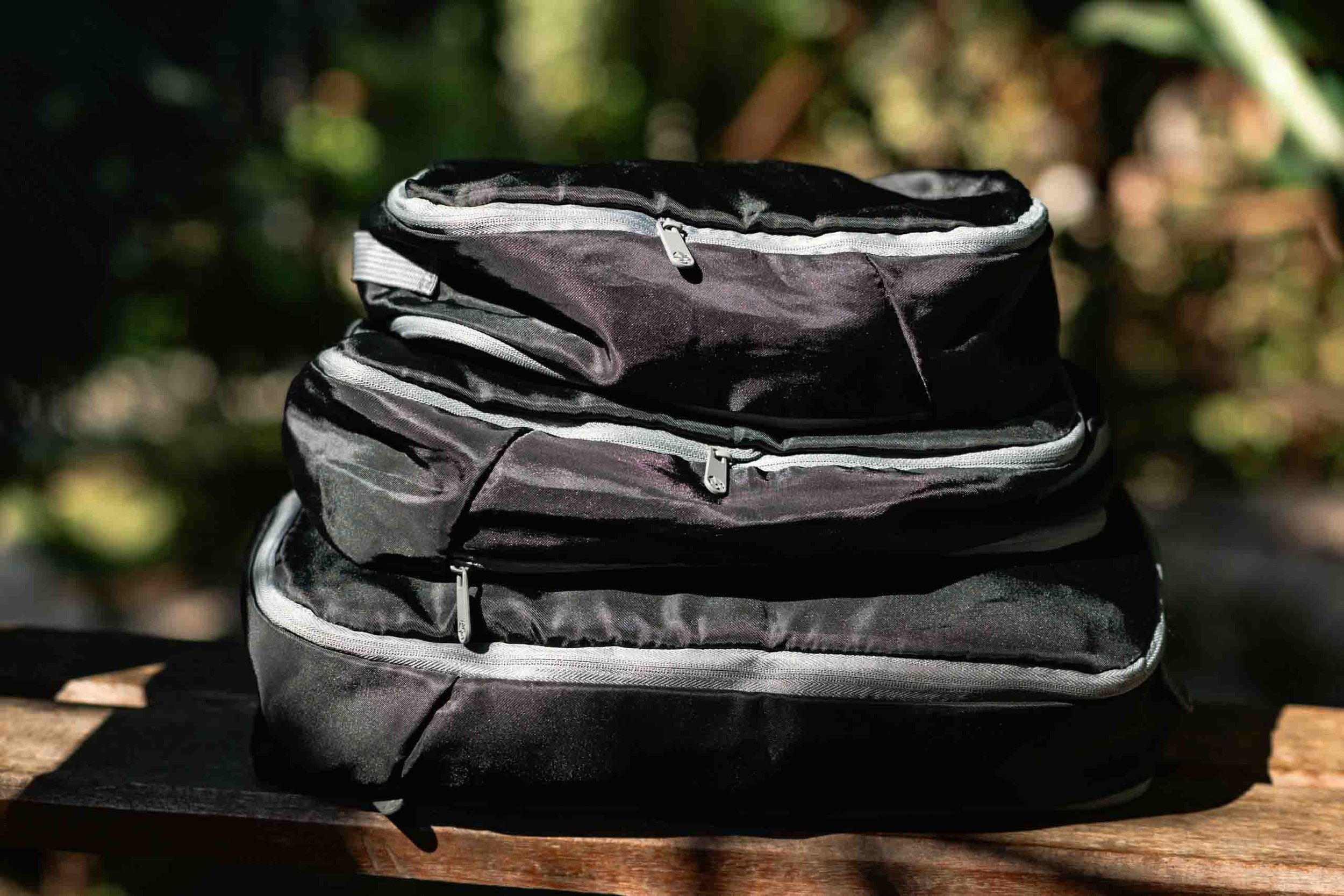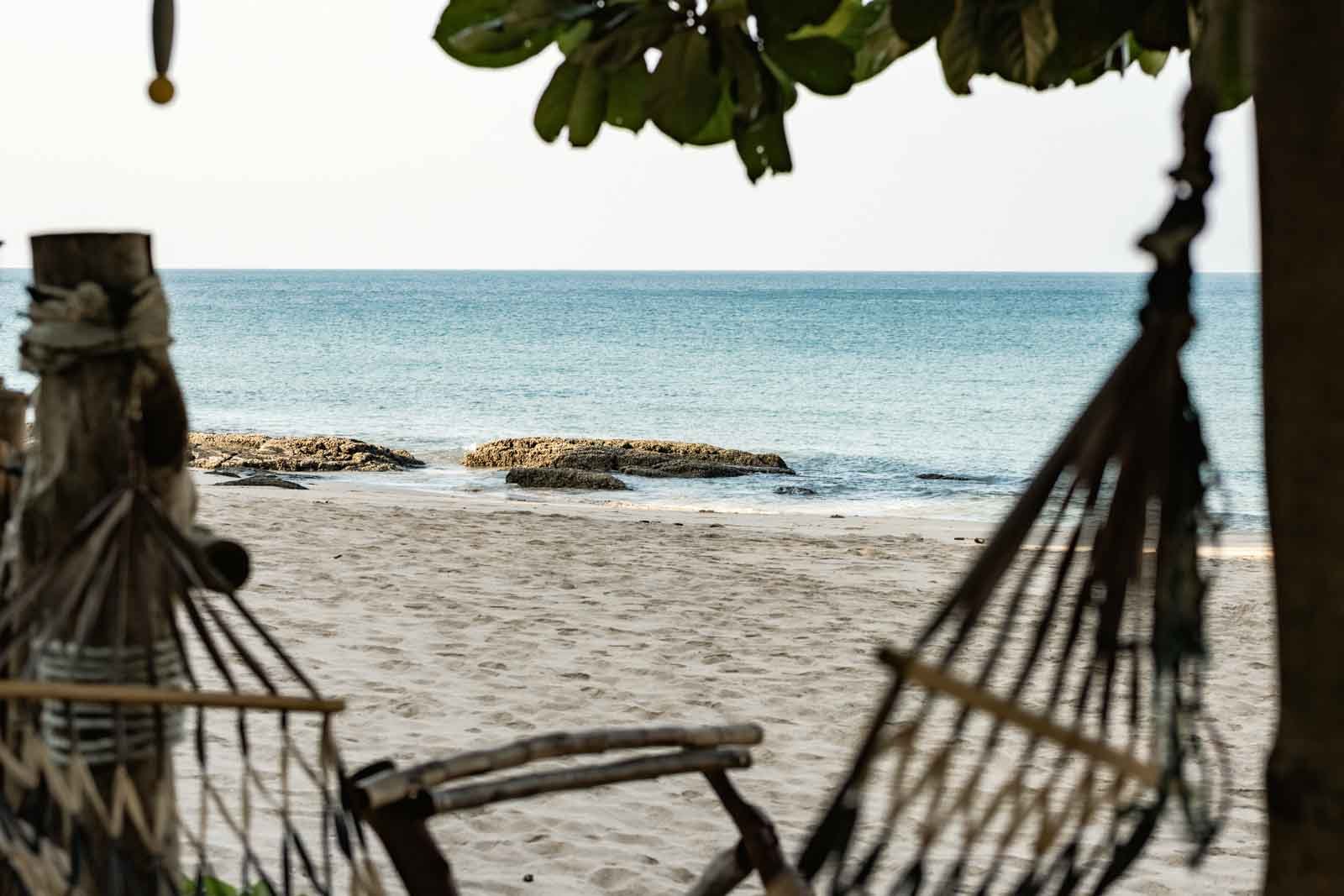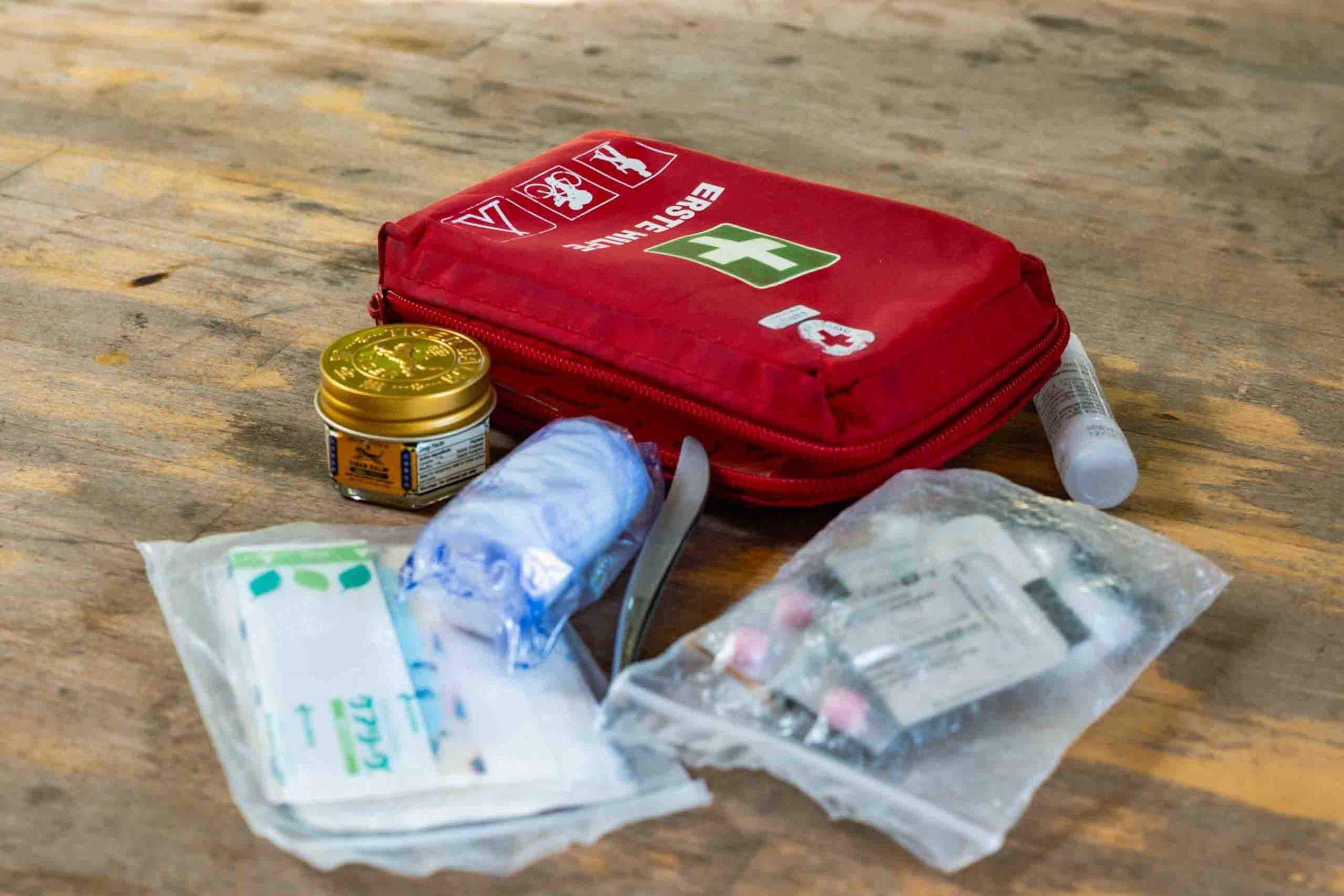
The ULTIMATE
World Trip
PACKING LIST
After 15 months and over 20 countries, we’ve refined the ultimate world trip packing list. Designed to handle diverse climates, cultures, and activities, it ensures you're prepared for everything—from tropical heat to chilly mountain air. Adjust it to fit your destinations, plans, and personal travel style!Our Backpacks
We spent some time searching for backpacks that suited our body types and provided the right size and fit. Durability and robustness were top priorities, as we wanted good-quality backpacks that would last through the rigors of long-term travel.
Sven owns an Osprey Aether 55, which is big enough for every item without being to big to carry around public transport. It has a sophisticated back panel, which helps to distribute the weight onto the hips. He likes that it can be opened both from the top and the front. The materials used are high quality and withstood dozens of flights, luggage compartments and van roofs.
Ingrid has a Thule Versant 60L. You can find a similar model here, as it seems it is no longer being produced. For her needs, it was important to choose a backpack that could be opened fully at the bottom, rather than just offering partial access from the sides or top. She finds it much more practical to be able to have full reach of her stuff without having to unpack everything, especially if she only needs one specific packing cube.
BUY |
Thule Versant 60 Asphalt (60L ) similar model
Packing Cubes
We typically organize our clothes in packing cubes for quick access: one cube for bottoms, one for tops, one for outdoor clothing, and so on. We have a laundry bag and reusable bags to store our shoes. For years, we stored our clothes in various reusable bags instead of using packing cubes.
While this method worked well for short holidays, we eventually realized we needed a more efficient solution for packing. The choice ultimately depends on your packing style, but we highly recommend investing in quality packing cubes to organize your luggage easily.
That's when we decided to give packing cubes a try. Initially, we opted for a budget-friendly set from IKEA, but the zippers didn’t hold up during our travels. For anyone planning a long-term trip, we strongly recommend investing in high-quality packing cubes to keep your clothes compact and organized. You don't necessarily need compression cubes, as your clothes will naturally compress when packed tightly inside your backpack.
BUY | Packing cubes
Raincovers
For our backpacks, we bought new rain covers after a few mishaps. Sven’s original rain cover got lost on the first flight, and the second one was hanging on his backpack not covering it by the time we picked the backpack at baggage claim. Ingrid’s original rain cover was really good, but we decided to upgrade.
The covers we have now can be securely closed from the back, fully covering the straps and most of the backpack. While the covers are a bit tricky to remove, once you’re familiar with how they work, they offer excellent security. This feature is especially important, as the design prevents easy access, helping keep your belongings safe from theft.
BUY |
Journext (only available in Europe)
Weight
We tried to minimize as much as we could, but we know they could even have less than what we actually carry. Sven’s backpack weighed originally 18 kg and Ingrid’s 13 kg. When the trip started, we had stock up items from our favorite products, even though we knew we could buy sunscreen or shampoo bars in other countries. The weight from our backpack fluctuates constantly, as we buy other goodies from our travels like tea, spices, mosquito spray or souvenirs. This fluctuation normally makes each of our backpacks 1kg to 2kg heavier.
We cannot emphasize enough on traveling lighter. We advise you to find some items you can compromise and leave them at home. For Ingrid her backpack is too heavy and it has been a struggle to hop in and out of public transport in a hurry. So we definitely recommend you to go do some rounds in your block, go hike some stairs or simulate a weekend getaway with your backpack to get a feel about how much you can carry.
Daypacks
For us, the ideal daypack needed to include hip straps for added weight support, two compartments for our water bottles, and a design that made the main zippers harder to access, providing an added layer of security against pickpocketing in crowded areas.
We have two backpacks: a medium-sized one and a small one. Depending on the activities and how much we need to carry, we choose the backpack of the day. Most of the time, we use the medium-sized bag for our daily adventures.
Whenever we’re changing accommodations or in transit and not using our backpacks as daypacks, we keep our e-reader, laptop, photocopies of important documents, camera, and other fragile items in them. These items are safer in our smaller backpacks, as they can be damaged if stored in our larger bags.
BUY |
Fjällraven Abisko Hike Foldsack (25 L)
Vaude Unuk II Daypack (6-15L)
READ| Everyday Essentials: The Must-Have Items in our Daypack

Clothing & Shoes
For our world trip, we needed to pack clothes suitable for all kinds of weather, knowing we’d be exploring the highlands of South America and the humid climates of places like Sri Lanka. We opted for natural fabrics like cotton, merino wool, and linen, as they are breathable and versatile. Layering was key, so we focused on lightweight options.
Additionally, we packed clothing that offered sun protection while also being modest enough to respect the cultural norms of the countries we visited. Our advice is to include at least one outfit that covers your shoulders and knees, and avoids cleavage, for temple visits or when traveling in more conservative regions.
THE REAL TRAVELER TIP


Toiletries
As a couple, we share most of our toiletries except for those that would be too disgusting to share.We prioritize solid over liquid products, eco-friendly brands, and zero-waste options. This saves space, reduces waste, and allows us to carry our toiletries in a carry-on. We keep everything organized in a toiletry bag and store leak-prone items in a Ziploc bag.
To minimize single-use plastics, we use travel-size reusable bottles, refilling them with our favorite products instead of buying disposable travel-sized versions.
Years ago, we switched from liquids to solid alternatives. We pack a body balm, bar soap, shampoo bar, and conditioner bar—cutting them down to fit all three into our compostable soap container. This not only reduces the liquids we carry but also keeps our routine simple and sustainable.
THE REAL TRAVELER TIP
If you want to cut down on waste and minimize your impact while traveling, we've put together a list of our must-have items to bring along.
READ | Eco- Friendly Travel: Sustainable Essentials for your Packing List

Sun, Beach & Sand
Each of us carries a pair of sunglasses and a snorkeling set. We recommend bringing your own only if you plan to snorkel frequently. We chose to get our own for hygiene reasons and to avoid issues with ill-fitting or difficult-to-adjust rental gear on tours.
For everything else, we share. A sarong is one of our most versatile items—it works as a temple cover-up, a beach dress, or even a towel.
THE REAL TRAVELER TIP

Rest & Recharge
We have been through it all: noisy streets, dogs barking, night-buses with neon lights. We need a restful sleep to be able to go through our day-adventures, that’s why we store these items in our daypacks when going on bus rides or flights.
We carry a sleeping bag liner in case the bed sheets were too disgusting, though we've only used it once. That said, we've generally had excellent accommodations. Additionally, we have our own compact travel mosquito net. We have used this in several accommodations especially in Central & South America. We have an extremely strong mounting tape, to mount the net instead of making holes in the ceiling. If you will mostly be traveling around Asia, you probably don’t need to buy one. Unless, you will be staying in dormitories, then we advise you to bring one along. It is more common to find rooms for couples with a mosquito net in this part of the world.
THE REAL TRAVELER TIP

First-Aid Kit
We carry two first aid kits: a small one in our daypack for everyday adventures, containing just a few essential pills, and a larger one in our main backpacks with more comprehensive emergency supplies.
Keep in mind that in many countries, over-the-counter medicine is readily available, and if not, your insurance should cover doctor's visits and prescribed medication. We prefer to know exactly what we're dealing with rather than self-medicating. After all, it's hard to tell if it's just a cold or something like a tropical virus.
Be sure to bring any medication required for your personal health needs, including any special treatments or supplies. If you have any specific medical conditions, it’s advisable to carry a doctor's letter confirming that you are approved to carry the necessary medication.
We recommend you to bring a face mask, you never know if the person sitting next to you is sick and you do not want to ruin your travel plans.
THE REAL TRAVELER TIP

Electronics
WWe store our cables and small electronics in a cable case to have everything sorted out.
We have a separate camera bag and its gear in case, we only want to take this bag instead of a backpack. We advise you to store silica bags with your bar, as in some countries the humidity might damage it.
We cannot recommend you enough to get headlamps, we have use them for early morning hikes, walking down dark streets, to read books and even to cook.
We started this trip with two used books we found on the street in Germany. Many people put in a box outside items they no longer need and we just grabbed them with the intention of swapping our reads. We always had the opportunity to swap in cafes, hostels, homestays and zero-waste shops. However, we did not always find those books we were dying to read. So we bought an eReader that we can use books from our public library subscription and those we are willing to buy.
THE REAL TRAVELER TIP

Documents & Security
We store important documents in the anti-theft bag and have a money belt for countries in which we do not feel safe carrying money around.
We advise you to have digital scans and prints of all of your important documents. Some countries want to see your insurance or vaccination certificate upon arrival.
THE REAL TRAVELER TIP

Reusable Food & Drink Staples
These are the items we always have in our daypack. We bring them along to store snacks, buy street food while avoiding packaging, or grab a drink without using single-use products.
We have our own cutlery set with a spork, metal straws, a cleaning brush and a collapsible food container.
We have two water bottles: an insulated water bottle and a regular bottle. We prefer the insulated bottle when we buy cold or hot drinks on the go. Double check at your accommodation, if they offer free refills or look if the tap water in the country you are traveling to is safe to drink. During most of our travels, free refills were offered. If not, we try buying big water gallons to distribute between days, cutting down the amount of small plastic bottles.
We also have a foldable bag that can be packed really small which we carry with us to avoid using plastic bags. We use ours for grocery shopping or for carrying some of our belongings between accommodations and trips.
THE REAL TRAVELER TIP
We've put together a list of sustainable items that should always have while traveling to lower your impact and reduce waste.
READ | Eco- Friendly Travel: Sustainable Essentials for your Packing List

Laundry
Depending on the country, we either use laundry services or choose accommodations with washing machines.
We opted for clothes that are quick-drying and made of natural fibers, such as cotton or bamboo. These fabrics resist odors and require less frequent washing.
We’ve got a refillable bottle with our laundry detergent, which comes in handy when we hand-wash or have washing machines in our accomondation. We have been able to refill at zero-waste shops or asking our hosts if we can refill our bottle. We prefer eco-friendly detergents to prevent waterways pollution and skin allergies.
To air-dry our clothes we use a compact travel clothesline and when our stays do not have a clothing drying rack or an outdoor clothesline. Alternatively, use hangers or shower curtain rods. This is not only better for the environment, but prevents your clothes from getting worn out faster.
When giving our clothes to a laundry service we pack our delicates in a mesh laundry bag. We have two different sizes: for small and big garments.